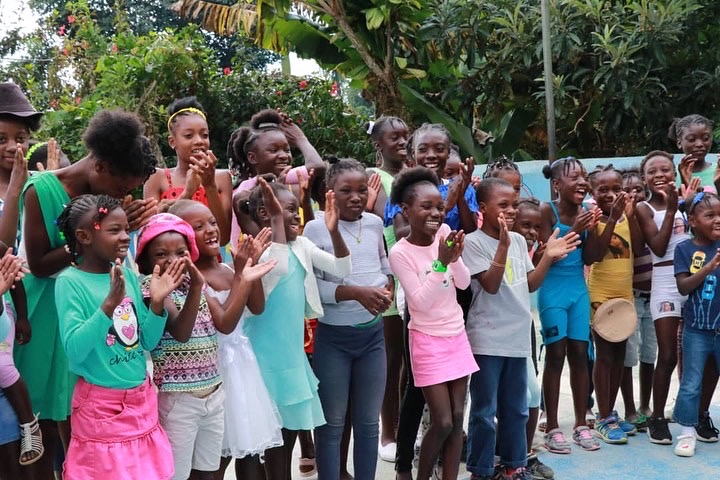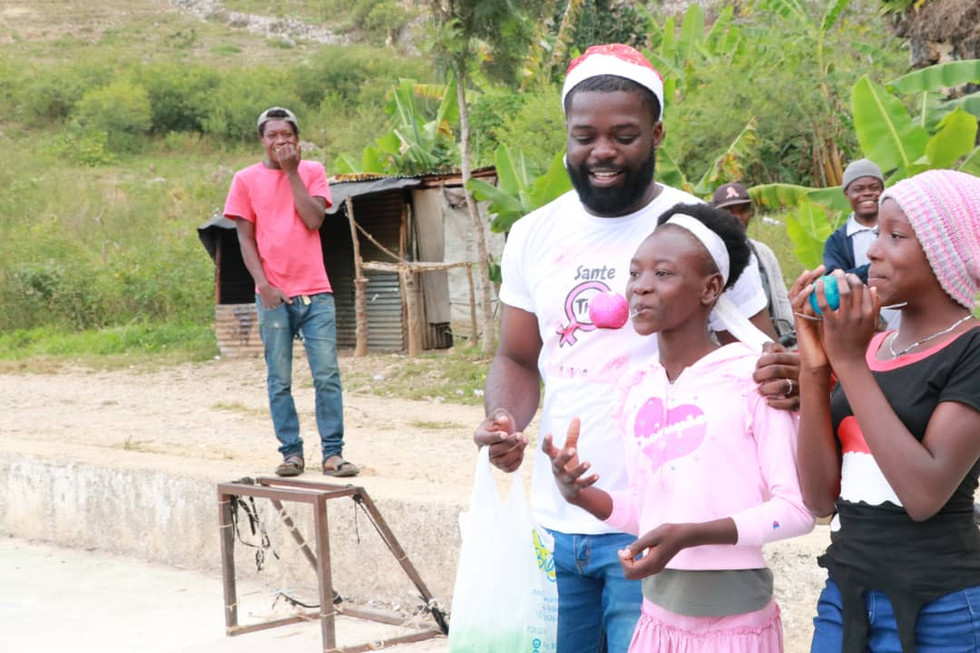SPARKLING CHRISTMAS IN BONGAR/KENSCOFF
- Chrystelle & Tayana

- Dec 18, 2021
- 7 min read
Updated: Feb 12
Haitian culture has always placed a strong emphasis on certain celebrations, including Christmas. During this time of year, “fanal” ( haitian made lamps which hildren often learn how to make from a very early age, decorate the streets and many houses. On Christmas Eve, particularly known as “24 Desanm,” music fills the air, and many people wear beautiful outfits to attend midnight mass, Mès Minwi. Children are allowed to stay up very late. If you speak to any Haitian child, you'll learn that both Christmas and New Year's are highly anticipated. Christmas is celebrated because of the excitement surrounding “Santa,” or Tonton Nwel for some, while New Year’s is all about the traditional "zetren" small gifts, often money, given to kids.
In various parts of the country, the traditional bouillon (goat head soup) is prepared. The process of making the bouillon seems to last forever while Christmas songs blast from different speakers. Indeed, each house can choose to play music as loud as their heart desire, creating a beautiful cacophony throughout the night. The same famous Haitian Christmas songs play on repeat, not the traditional “jingle bells” but songs like Mikaben's Yon 24 Desanm and Lionel Benjamin's Se Mwen Abendwel. What Haitian child doesn’t know these songs?
What makes this celebration truly special is the palpable resilience and the strong sense of community during this time. Whether rich or poor, you can be sure that your neighbor—whether they know you or not—will invite you to celebrate or share a meal with them. The joy amidst the suffering is something that’s difficult to describe, even in the poorest neighborhoods. It could be seen as a commitment to choosing life and happiness, regardless of all the uncertainties. Amidst all the celebration, we at Santé Tifi decided to join the people of Bongar to celebrate Christmas and use this opportunity to educate and empower the girls in their community.
Why Bongar?
Bongar is an extremely rural community located in the mountains of Kenscoff.The beautiful mountains of Kenscoff are home to many farmers who do their best to cultivate fresh vegetables, such as spinach, parsley, tomatoes, and bell peppers. The food is as organic as it gets and more flavorful than anywhere in the world. While Kenscoff is known to house the elite of the country, it is more than shocking to see that at walking distance is also a community so exposed to life’s most cruel challenges. The vast inequities between life in Bongar and its surrounding areas remain a stark testament to the wealth disparities that persist in the region. In Bongar farmers families only have access to one public school. Who would think that feeding the population organic food would come at such a price ?
To make a difference, we partnered with the Casec of Bongar, who grew up in the area and recognized the need for such an intervention. Our mission in Bongar was to give back and make this small community feel seen, valued, and deserving of better programs and education.
Our adventure began early in the morning on 12/18 in Pétion-Ville, where the team gathered to prepare the equipment needed for the session. We were filled with purpose, and the fresh air flowed through the car as we made our way up the road to Kenscoff, windows rolled down. The atmosphere was as light and refreshing as the breeze we felt, but we had no idea how perilous this journey would be. Perhaps that lightness gave us the energy we needed to face the adversities ahead.
As soon as we left the paved roads of the Kenscoff route and entered the entrance to Bongar, the journey took a turn. The roads went from paved to bumpy and dusty. Due to the rainy season and constant erosion, the unpaved roads had become nearly impracticable for our SUV minivan. The car spun out, and we had to adapt our mode of transport. We started our hike and still, everyone remained upbeat. determined to make it to Bongar, rain or storm. While hiking, we had the chance to admire the breathtaking view of the city below with the car spinning behind us as best as it could, leaving us with only our commitment to the community to guide us forward.
It was foolish of us to assume that once we reached the top of the hill, the journey would be over. We soon learned that getting to Bongar required not just going up the hill, but also descending into a small community hidden deep in the mountains. Not only was the road down unpaved, but it was a sharp, treacherous descent—downright dangerous. We quickly realized that our urban driving expertise was completely useless in this situation.
Thankfully, the CASEC graciously arranged for a local driver from Bongar who knew the terrain and could bring us safely down. The journey was becoming increasingly risky, and it was the moment you’d expect at least one person to back down from the mission. However, none of us hesitated. Instead, we doubled down on our commitment to finish what we started.
We loaded our gifts and belongings into the back of the jeep, with all of us holding onto each other or the metal bars on the sides. There were no benches, no comfort—just the reality of the journey. From above, we thought we were brave enough to continue, but as the car descended, shaking with every turn, one wrong move could send us off the cliff. Not a word was spoken. We were all too anxious, silently praying that the journey would end soon.

But when we finally made it down to Bongar, we quickly realized that it was all worth it. Our emotions were all over the place—shocked, happy, and fulfilled. We were shocked to see that what the locals considered a school was just one classroom, with a dusty floor, a few metal sheets patching the ceiling to prevent rain, and a piece of plywood serving as a chalkboard. We were happy to feel the warm welcome of the community. It was clear that our arrival was a significant event for them, and we could sense that they felt blessed and grateful to have us among them.
The Sante Tifi training took place in this modest room, made of tin and clay, which serves as a classroom during the day and becomes a meeting place for adult literacy in the afternoon.
We then divided the young people into small groups to make the workshops more accessible and engaging. Among the activities offered was a workshop on puberty and menstruation led by Lisa Bonhomme. During this session, we also distributed reusable pads, as access to these products is limited in Bongar due to its remote location. The pads, crafted by Days for Girls, were enthusiastically received by the young girls.

We also held a classic "building self-esteem" workshop, a skill that is greatly needed in the peyzan community, who are often seen as lower-class citizens. This workshop focused on bodily autonomy and used dancing and catwalking as tools to boost confidence. To conclude the session, we distributed small gifts, including makeup, jewelry, and hair accessories.
Finally, as usual, Gancharlem , Kemly and Cineas hosted a workshop focusing on building allyship and combating gender-based violence, in which many boys from the community participated. We also brought clothes for the boys, who expressed their delight, noting that they rarely have access to new clothes. These gifts were seen as a valuable form of support, especially since they were eager to use them for the Christmas holidays.

To crown the initiative, we engaged in wonderful games and dancing, as it was, after all, a prelude to the Christmas celebration, led by our wonderful Azor Kemly. As soon as the music and dancing began, word spread quickly. Other young people, working in the fields, came to join us, while the parents watched, amazed and happy to see their children living life so vivaciously.
Our numbers quickly quadrupled, giving us the feeling that we had united the entire community around our initiative, strengthening bonds and allowing everyone to participate in this process of exchange and learning.

The Bongar experience remains, to date, our greatest success story—a major turning point in our modus operandi. We were finally empowering the voiceless, the intentionally forgotten ones, and the “moun mon” that nourishes so many with organic food. However, this experience also highlighted one crucial issue. On one hand, access to education and training in sexual and reproductive health is a fundamental right that many young people, especially girls, struggle to exercise due to their remote location. On the other hand, the lack of appropriate infrastructure in some rural areas makes access to comprehensive education and reliable health information by healthcare providers and experts even more difficult.Therefore, it is essential to build capacity in these communities so that their leaders can better empower women and girls. This experience raised the important point of making this initiative sustainable, enabling the communities to lead and take care of themselves. While we cannot control which roads are paved or accessible, we can build a chain, training the leaders so they can educate their community, making Santé Tifi a lasting force for change.
In this context, initiatives such as Santé Tifi's are essential to provide young girls, and the whole community, with the tools they need to overcome these obstacles and take their future and the future of the coming generation into their own hands.

NB: This initiative was made possible because of the incredible generosity of so many of you who donated through our Amazon wish list. We are deeply grateful to everyone who helped bring this vision to life, including the CASEC in Bongar. But most of all, this journey would not have been possible without the amazing group of dedicated young adullts volunteers who, despite the countless obstacles, refused to give up and commit to serve their country . Their unwavering commitment and heart have truly been the driving force behind this project, and for that, we are beyond thankful.



















Comments